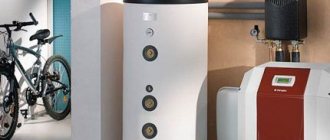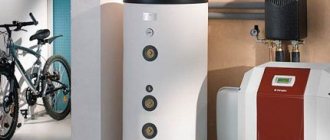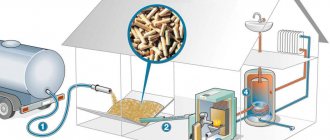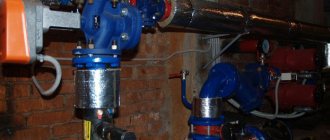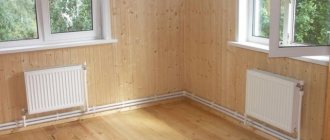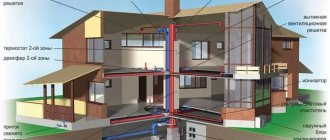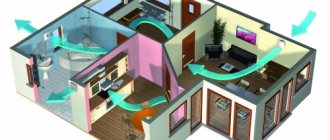For many homeowners, creating an autonomous heating circuit is the only way to heat their home if it is impossible to connect the building to a centralized heating main. To ensure efficient heating using the created network, a pump is installed in the heating system of a private house. Tell us about the advantages of having such a device in the thermal circuit of a building. Let's also consider the types of pumps, important parameters for selecting an electrical appliance, and the features of its installation.
Installed pump in a private residential building Source 1-teplodom.ru
General information
Previously, all houses installed a system through which the working environment moved naturally. The movement of water was ensured by heating it in a boiler or even an ordinary furnace. It cooled in the radiators and other elements of the building’s thermal circuit, after which it was returned to the heating equipment. It was according to this simple scheme that it circulated through the pipes.
Nowadays additional equipment is used everywhere. Before installing a pump in a heating system in a private home, specialists perform calculations and select a device, taking into account the characteristics of the building’s thermal circuit. Professionals also take other nuances into account.
On a note! A thermal circuit with natural circulation is just a relatively simple heating circuit. After all, when installing it, pipes must be laid with a slope, batteries are mounted in strictly specified places, and pipelines of exceptionally large diameter are used. In some buildings, all the rules are difficult or impossible to comply with. Therefore, it is not possible to ensure the required coolant circulation through the system.
Conventional diagram of the thermal circuit of a building with natural movement of coolant Source rtkpipe.ru
Professional installation of additional equipment allows you to solve these problems. Most homeowners turn to specialists for help. After all, they know very well how to properly install a circulation pump in a heating system.
Launch rules
After installing the pump, it will need to be started. When performing such work, you should perform the following steps :
- fill water pipes made of copper, steel or metal-plastic with water and create static pressure in the system;
- using automatic air vents or a tap, remove air from the unit;
- turn on the heating device (boiler);
- turn on the pump and make sure that water circulates in the system;
- let the unit operate for several minutes;
- turn off the device and remove any remaining air from the system.
The advantage of a system with a pump
Opponents of heating, characterized by forced movement of the medium, note the following disadvantages:
- installing a circulation pump forces you to increase the cost of installing a heating circuit;
- equipment requires an electrical connection, which causes additional costs for electricity;
- the efficient operation of the pumping unit depends on the stability of the power supply, which does not exclude the occurrence of emergency situations if the power supply is interrupted;
- installing an electric pump forces the installation of the entire unit and its regular maintenance, but even in this case it is not protected from breakdowns.
Pumping unit in the heating network of a house Source sovet-ingenera.com
Upon closer examination of each non-delivery, the disadvantages turn out to be not as significant as they seem at first. Moreover, to organize the effective operation of a thermal circuit with gravitational movement of the coolant, one cannot do without certain knowledge, experience, and the implementation of specific rules. Therefore, for its proper installation, you will need the help of specialists who also know perfectly well how to properly install a heating pump in a private home.
To finally find out all the advantages of having a circulation pump unit in the thermal circuit of a building, you need to become more familiar with the system where the coolant moves by gravity.
Schematic diagram of a gravity heating circuit Source oboiman.ru
After determining the installation location of the boiler, be sure to lay a vertical pipeline. It is the accelerating section of the system. For its arrangement, pipes with a large diameter are used. It is recommended to install pipes with a cross-section of at least 1.5 inches.
The acceleration pipeline is laid to the maximum possible height. It should be mounted to a point that is higher than all the radiators in the house. After this, the expansion tank is secured and connected. This device usually has an open design.
The coolant supply pipeline from the expansion tank is laid with a slope of at least 5%. In other words, the slope of the pipe must be at least 50 mm per 1 m. In this case, its cross-sectional size must be at least 1.25 inches.
Descents to radiators are made of pipes with a minimum diameter of 3/4 inch. The return manifold, which is also placed on a slope, is made of rolled pipe with the same cross-section as that of the upper supply pipeline.
Gravity-flow system with an open tank for expansion of the working medium and an accelerating pipe Source tvoya-stroika.ru
Such a heating device with gravity flow forces the boiler to be installed below the radiators. This is not always convenient or possible. In addition, the length of pipelines is increasing. To avoid all the inconveniences, turn to specialists who know very well how to install a circulation pump in the heating system of a private home. After all, it is this that will allow the supply of heated water to the battery at any point in the building.
It is still possible to implement a gravity circuit in small houses where all heated rooms are nearby. However, even with this arrangement of rooms, it is not always possible to install a system with gravitational circulation.
The need to use pipes with a large cross-section makes it necessary to spend more money on organizing heating. Such pipelines are more difficult to install and very difficult to hide in building structures, and sometimes this cannot be done at all. At the same time, professional installation of a pump in a heating system will cost less than the cost of installing a gravity circuit with large pipes and many associated costs.
Pump in the heating circuit of a house Source onlinetrade.ru
Another disadvantage of the gravity system is the inability to conceal the bottom connection of the batteries. This cannot be done even if the project is developed by experienced designers. In a circuit with coolant gravity flow, it will not be possible to create a pressure greater than 0.6 atm. After all, it is formed in the system due to temperature changes and due to different densities of the liquid.
Important! Pressure 0.6 atm. not enough for modern radiators. In addition, you can forever forget about water-heated floors, which are always installed correctly by specialists. However, for them to work effectively, you will need to install a heating pump. If the device is professionally selected, it will always create the required pressure.
An electric pump to create and maintain the required pressure Source leroymerlin.ru
In order for the gravitational circuit to operate at its designed power, it needs a starting impulse. It can only be obtained by increasing energy resources. If even a short shutdown of the boiler unit occurs, then it will take a long time to bring the heating circuit back to normal operation.
In addition, in a gravity circulation system, fluid moves slowly. Its movement is carried out due to the energy of the boiler, and this reduces the efficiency of the unit and the entire intra-house heating circuit. All these problems can be solved by installing a circulation pump for heating - professionals will help you how to install the unit correctly.
Important! Even inexpensive circulation equipment consumes a maximum of 90 W per hour. More expensive models have lower characteristics. It is significantly less than the total energy consumption that will occur when operating heating with gravitational movement of the coolant.
Characteristics, including power, of common circulation units Source 1-teplodom.ru
See also: Catalog of companies that specialize in engineering systems (heating, water supply, sewerage and others) and related work
The low speed of the working medium in the gravitational system is one of the reasons for uneven heating of radiators. In this situation, the heat transfer of the batteries can only be regulated by changing the amount of coolant that passes through them. However, this method will not allow for precise adjustment.
If we take into account that the pressure in the circuit is still low, then there is a high probability of blockage of one of the batteries in the house or even an entire section of the system. In this case, you should completely forget about the possibility of mixing coolant from the return pipeline. Therefore, you shouldn’t even think about high-quality regulation of heat transfer from heating devices.
The conclusion is that the gravitational circuit is not an effective system. Its arrangement leads to irrational consumption of energy resources. Therefore, it is better to spend money once on installing additional equipment than to pay large sums annually for the operation of an inefficient heating circuit. All owners of private residential buildings are recommended to contact professionals who know perfectly well how to install a heating pump in a private house.
Installing a pump in a heating system Source stroikairemont.com
The operation of the circulation pump completely depends on a stable supply of electrical energy. This problem is solved by installing an uninterruptible power supply. It can also simultaneously ensure the operation of the boiler unit. It all depends on its characteristics. Experts will also always help you in choosing a device.
On a note! Even an inexpensive UPS will allow boiler equipment to continue operating when problems arise with the central power supply.
If it is decided to connect a circulation pump, then the homeowner can consider switching the operation of the heating circuit to gravity circulation of the coolant. In most cases, experts offer just such a scheme to owners of modern houses. It involves installing a bypass. A pump and two valves are installed on it. The third shut-off valve is installed in the area that bypasses the bypass.
The advantages of the pump also include its durability if it is manufactured by a reputable company. Homeowners do not have to worry about the vulnerability of such equipment. Typically its service life is tens of years.
Most modern circulation pumps are durable equipment Source elektro56.ru
All pumping units must be serviced regularly to ensure they operate properly for many years. However, the benefits of such a device are undeniable. Therefore, even the purchase of an expensive pump is justified.
Control method
It is quite acceptable to constantly maintain the circulation of hot water in the pipes, but this is uneconomical and unjustified. Hot water is not used constantly. At night, while all the residents are sleeping, it is useless to keep the water in the pipes hot, the same applies to the time when everyone is at work or school.
If the pipes are laid out correctly, then thermal insulation is required, so that once hot water gets into the pipes, it does not cool down instantly. Therefore, there is no need to constantly pump water from the boiler into the pipes and back; periodic operation of the pump is sufficient, which reduces the load on it and the hot water system as a whole. There is no need to talk about saving electricity, since the consumption of the recirculation pump is low.
Two main control methods are used:
- according to temperature sensor readings;
- according to a timer (schedule).
Both options are in demand, although they differ significantly in their operating principles.
By temperature sensor
Grundfos UP 15-14 BT 80
The pump control unit in this case relies on the readings of a temperature sensor immersed in water inside the circuit pipes. The pump resumes operation as soon as the water has cooled to a certain threshold temperature. This approach significantly reduces the load on the equipment and constantly keeps the water in the pipes heated. In addition, the safety of the hot water supply increases. Having set a sufficiently high response threshold, water is pumped more often through the boiler, where it is additionally heated and disinfected.
By timer
Grundfos UP 15-14 BU
The control unit alternately turns the pump on and off based on the time delays set in the settings. Knowing exactly the parameters of the hot water system, the length of the pipes and their internal volume, thermal insulation and average heat loss, you can select the optimal time during which the water will not have time to cool down. The pump is turned on by a timer signal and pumps all the water. In this case, the duration of operation is also calculated based on the volume of pipes and pump performance.
Another advantage of the timer is the ability to schedule the operation of the recirculation pump for a day or even a week. It is in this case that downtime when hot water is not used is taken into account.
Main types of pumps for the heating circuit of a private house
Many well-known companies are engaged in the production of circulation pumps. For example, these are Wilo and Grundfos. Regardless of the brand, devices require electricity to operate. In the devices, the hydraulic and electrical parts are isolated from each other. This division is performed in two ways. The design of the pump depends on the specific option.
Dry type pumps
This type of pumping equipment is distinguished by the presence of a so-called dry rotor in its design. In such a device, the hydraulic part is completely separated from the electric drive. In this case, the impeller rotates due to the movement of the shaft around its axis.
Dry-type circulation pumping equipment Source simpalsmedia.com
Pumping equipment with a dry rotor has an elongated housing, since the electric motor is located on the side of the hydraulic unit. Due to this massive shape, a cantilever installation of the circulation pump in the heating system is performed. The installation process is simplified due to the presence of special brackets on the body. The equipment may also have an installation platform.
Pumping electrical appliances with a dry rotor are powerful devices with high performance. They are installed when it is necessary to supply a large amount of coolant. In addition, such pumping devices are capable of creating the necessary pressure to move liquid through extended systems. Therefore, their installation is carried out in large mansions with several floors.
Dry-type pumps have a number of disadvantages:
- Labor-intensive installation due to large dimensions.
- A complex sealing system on a rotating shaft that wears out during operation. Therefore, it is necessary to constantly carry out maintenance, and sometimes even change the sealing elements.
Dry-type pumping equipment with a complex sealing system Source yut-market.ru
- High noise level during operation, as the electric drive is cooled by air. Because of this feature, the installation of a circulation pump in a heating system in a private house is usually carried out in a boiler room, isolated from other rooms of the building.
Wet pumps
Pump circulation devices with a so-called wet rotor differ in design from electrical appliances of the “dry” type. First of all, their pump operating unit is connected to the power element hermetically due to the presence of ring gaskets between them. The two parts are screwed together.
The working unit has the shape of a snail. On both sides there are fastenings that allow connection to heating pipelines. Typically, manufacturers equip equipment with threaded pipes or flanges. The first elements allow coupling connections to be made.
Design of a household circulation pump Source superpumps.ru
The power section contains the stator winding. The pumped liquid never gets into it. To seal this part, the design contains a stainless steel glass. Therefore, the sealing elements are placed on fixed parts. Because of this, they do not wear out when the circulation pump for heating is running - specialists always know how to install it correctly.
An impeller is attached to its rotor shaft. These two parts are rigidly connected to each other. The bearings on which the rotor rests are lubricated with coolant. At the same time, it fills almost the entire space of the device. This allows heat to be effectively removed from the heating parts of the pump. Therefore, it does not overheat and does not need an additional cooling system.
Important! The “wet” type pumping device has an end plug that is used to remove air from the housing. This ensures that the entire device is completely filled with liquid.
At the end of the electric pump there is a plug for bleeding air. Source saucyintruder.org
When the rotor rotates in the working environment, energy losses occur. This reduces the efficiency of pumping equipment. However, this is a minor drawback, since the device consumes a minimal amount of electrical energy.
When operating a “wet” type electric pump, there is practically no noise. The device is easy to install and compact in size. However, you still need to know how to properly install the heating pump. After all, there is one important rule - the rotor axis must always be horizontal. In this case, the device body itself can occupy any position depending on its shape. If the rotor is positioned horizontally, then its bearings will always be wet, which prevents them from breaking due to excess heat.
Important! A filter is installed in front of the pump, which prevents solid particles from entering the bearings of the device.
Recommendations for selection
The standard temperature range at which both types of pumps can operate is 2–110°C .
If home owners leave for a long time in cold weather, turning off the heating, they will need equipment capable of working with low-temperature . In this case, the system must be filled with non-freezing coolant.
start such a device at a temperature in your home of -10-15°C without hassle, but a pump operating in the normal temperature range may break down in this case.
When selecting a circulation pump for hot water supply, it should be taken into account that the housings of devices for hot water systems must be made exclusively of bronze or stainless steel . The impeller is usually made of heat-resistant plastic.
If you install a unit with a cast iron body into the hot water system, then, of course, you can save a little. But this is not worth doing, because the iron content in the hot water system will increase , and the likelihood that the rotor will quickly jam due to a large accumulation of deposits will increase sharply. This may damage the electric motor.
There are units on sale that are not afraid of jamming. They are equipped with a spherical rotor . The magnetic field in this case is transmitted through the conductive parts of the pump in the aquatic environment.
A spherical electric motor, unlike a traditional one, does not have bearings. The chamber in which the rotor is located is separated by a spherical glass made of stainless steel from the stator. Therefore, such pumps are less susceptible to impurities contained in water and lime deposits.
To clean the device, you need to disassemble it. In this case, the housing does not have to be removed from the pipeline. You will only need to disconnect the engine from it by turning the threaded ring .
To improve system reliability, a dual pump can be used . It has one impeller, which moves thanks to two electric motors that turn on alternately. Both motors are located in the same housing. If one of them breaks, the second one will turn on automatically. In a normal state, they replace each other after the same time intervals.
Basic selection parameters
Before connecting a circulation pump to the heating system, professionals select a device taking into account the features of the existing heating circuit of the house. During this process, they must pay attention to the following parameters of the device:
- The operating voltage should be 220 V. This characteristic allows you to connect the electric pump to a household power line. Therefore, there is no need to install separate wiring.
- Power – the optimal value is the minimum value. It is recommended to choose a device with power consumption class A. This device is the most economical. As the class decreases, power consumption increases.
Manufacturers produce modern pumping units with two or even three operating modes. They allow you to change the pressure of the pumped liquid. At the same time, the power of the device will change. These parameters are usually marked on the body of the electric pump.
Stages of connecting gas boilers
The scheme for connecting a gas boiler to a heating system is quite complex, time-consuming and requires certain knowledge and experience. Gas boilers become more and more efficient and safe with each generation; automation and regulation become more complicated. Universal boilers are widely used, which not only heat the room, but also heat water.
Manufacturers develop leaflets and instructions that explain how to correctly connect a double-circuit gas boiler to the heating system. Despite the difficulties, you can figure out the installation stages yourself. This is much more economically profitable, because installation work is very expensive.
To figure out how to connect a gas boiler, you should break down all the steps into several stages:
- installation of the unit (or wall mounting if it is a wall-mounted option);
- work on connecting a water heating circuit;
- connection to water supply (double-circuit heating units);
- connection to the gas pipeline;
- commissioning works.
In order for the boiler to operate safely and efficiently, you need to understand the features of each stage.
Before you begin installation, you need to purchase all the necessary consumables, decide which pipes to connect the gas boiler and find out what type it is:
- Single-circuit boiler. It has one heat exchanger and is intended for heating only.
- Double-circuit boiler. Serves two heat exchangers: one circulates the coolant for the water heating circuit, the second is designed to solve the problem of hot water supply. In summer, the main circuit is turned off. Connecting a double-circuit boiler with your own hands requires care.
Heating systems are also different: closed or open types. The coolant can circulate forcibly or by gravity. However, the principles for connecting boilers to heating systems are the same.
Installation of an electric circulation pump
Before starting installation work, each specialist already knows where to install the pump in the heating system - on the supply or return. Typically the installation is carried out on the return pipe. Installation is carried out directly in front of the boiler. In this case, it is better to choose a place after the tank in which the coolant expands.
On a note! It is recommended to install expansion tanks with a membrane in heating systems with quiet movement of the working medium. It is for this reason that the installation of electric pumps is carried out after them. After all, a device for circulating coolant contributes to the creation of flow turbulence.
If an open tank is installed, then the electric pump can be installed anywhere in the common return pipeline, but only after the last connection into it. The same recommendation applies to the membrane expansion tank. The location of the electric pump on the return line after the expansion tank extends the service life of the circulation device. Indeed, in this case it will pump a cooler coolant than when installed on the supply side.
Layout of the pump on the return after the expansion tank Source 1-teplodom.ru
Important! Modern pump models are designed to operate at a maximum temperature of 110°. This allows them to be installed on the supply pipeline. However, when choosing this option, you need to carefully balance all the parameters of the thermal circuit. After all, after the pumping unit, the working environment receives a vacuum. Taking this point into account, circulation devices should not be installed immediately behind the boiler, since when the heating circuit operates at maximum, boiling of the liquid in the batteries may occur. This situation poses a great danger.
Advice! If the pump is installed on a supply pipeline, then it must be installed at the greatest possible distance from the boiler unit.
Before connecting a circulation pump, professionals always first study the existing system. If branches extend from the central supply pipeline in different directions, pumping devices are installed on each of them. Such heating circuits are often found in buildings with extensions or in large houses that have two wings.
One of the options for a branched heating circuit with two circulation pumps for radiators and heated floors Source akak7.ru
In buildings with a branched thermal circuit, the optimal place to install the electric pump is the supply pipeline, but only after it has branched. In this case, the circulation device must be installed before the battery or the first riser.
When choosing a location for a circulation device, they are guided by the heating scheme in a particular house. There is no general rule for the placement of a device that pumps coolant. Specialists take into account the characteristics of a particular heating network and the availability of free space on its pipelines.
In addition, professionals control the location of the device’s rotor axis relative to the ground. It must always be parallel to the horizon. In addition, access to the electrical pump installation box is provided. After all, it is designed for connecting wires and there is a mode switch in it. Therefore, the installation box should not be located at the bottom of the device.
Where should the device be installed in the heating system?
The device is mounted on the line immediately after the heat generator installed on it, up to the first branch branch.
Where is the best place to install the device?
The performance of the pumps on the supply and return branches will be equally effective, since the difference in the static pressures of the coolant in one direction and the other is not significant and does not affect the heating of the room.
Are there any exceptions?
Yes, if cheap boilers operating on solid fuel are used. They lack automation. Therefore, in case of overheating, the coolant boils. Problems begin when the electric pump fills with water and steam. It comes out through the body of the device with the working wheel, and the following is observed:
- Gases affect the pump impeller and its efficiency decreases. The coolant begins to circulate more slowly.
- There will be insufficient liquid flowing into the tank. Overheating of the device is inevitable, and even more steam is formed, and when it enters the impeller, the heated water stops its movement. Increased pressure causes the safety valve to operate. The steam is released directly into the boiler room. An emergency situation is evident.
- If the heat source is not immediately extinguished, the valve will not be able to overcome the load, and an explosion will occur.
As a rule, no more than five minutes pass from the moment of overheating to the time when the fuse valve trips. When installing the pump on the return branch, this time is 30 minutes, and it is quite enough to stop the heat supply. Hence the conclusion: it is undesirable and, moreover, dangerous to mount a circulation device on the supply branch of the heating main. It is better to install pumps for solid fuel boilers in the return line of the pipeline. This condition does not apply to systems with automation.
Features and installation procedure of the electric pump
To find out how to properly install a circulation pump, it is recommended to use the heating project. It is usually developed during the design stage of the house. If the heating circuit of a building is being modernized, then in this situation the best place to install the device is the bypass.
The presence of a jumper with an electric pump, filter and shut-off valves allows the heating network to function if the building loses power or an electrical appliance breaks down. Thanks to the bypass, it will be possible to switch the system to circulate the medium naturally. This will prevent you from being left completely without heat in the event of an emergency.
The bypass jumper can have almost any configuration. Often there is not enough space for installation. Therefore, non-standard solutions are being implemented. However, more often the installation is still carried out according to standard schemes.
One of the options for a bypass jumper for an electric heating pump Source e.allegroimg.com
If there is free space, a ready-made bypass assembly is usually installed. This design is manufactured in production shops. It is equipped with taps or valves are built into it. The finished bypass unit can be mounted by welding or connected via thread. Any such structure has a free area intended for installing an electric pump using flanges or couplings.
Thermal circuits in houses are often created from polypropylene pipes. This option simplifies the process of installing a circulation device for pumping coolant. The master usually spends about 1 hour on the work. More time is required if installation is carried out on metal pipes. It is necessary to use not only welding, but also packing of threaded connections.
During installation of the circulation pump, the technician carries out the following actions:
- prepares components - filter, shut-off valves, threaded pipes, drains;
- connects all threaded elements of the assembly using a special sealing tow and paste;
- assembles the loop together with the pump without carefully tightening the union nuts;
An assembled loop with a pump and a unit that is mounted underneath it Source 1-teplodom.ru
- outlines and cuts out an area on the return line for installing the tap;
- carries out welding work - first tacks the metal elements of the assembly, then removes the pump to prevent it from being damaged by welding splashes and completes the operations started;
- assembles the unit under the pump and carries out its installation;
- the circulation device is installed in place;
- carries out the final tightening of the American electrical appliance.
Important! On the electric pump, the direction of the arrow must coincide with the actual movement of the working medium in the heating pipeline.
At the end of the work, the master connects the wires. They are connected to the terminals located in the mounting box of the circulation device.
Connection options
An open-type heating system with a pump can be implemented using one of the proposed methods. Each of them has its own strengths and weaknesses, but you should make your own decision about which of the proposed options is right for you. For example, for a garage the first scheme will be appropriate, while for a building with several floors a different implementation will be needed.
Hybrid
This option assumes that in the event of a power outage, the circuit will continue to operate according to the emergency option, and even with minor losses, it will still continue to supply heat where it is needed.
It is implemented using a horizontal pipe laying method. The pipes must be larger in diameter than with other connection options. The coolant, heating up in the boiler, rises through the pipes thanks to the laws of physics, and flows through a horizontal pipe located under the ceiling with a slight slope. From the main pipe there are bends down to the radiators. Moving according to the proposed scheme, the water cools and flows down, going into the lower horizontal route, along which it returns to the boiler for reheating.
The disadvantages of such a connection are the need to lay an upper route from large-diameter pipes, which attracts attention, low circulation speed and uneven heat distribution. In addition, such an option must be carefully calculated, using pipes of different diameters in different areas to compensate for heat distribution. And there is only one advantage, but what: the system is autonomous and, in combination with a solid fuel boiler, practically requires nothing but fuel
But there is only one advantage: the system is autonomous and, in combination with a solid fuel boiler, practically requires nothing but fuel.
When there is electricity, water is pumped through the pipes, the speed of the current increases, heating occurs faster and spreads more evenly.
Single-pipe
The option is practically no different from the one described above, except that the pipes can be taken of a smaller diameter, and the riser can be run along the floor. This connection option is known as Leningradka, in honor of the city where it was developed and first implemented.
Leningradka is an excellent way to install heat in a house; it is implemented as follows: Water, heated in the boiler and pumped through a pump, moves along a horizontal riser. From which branches go upwards to the heating radiators. The riser itself can be hidden in the floor. Installing needle valves at the inlet and outlet of the radiator allows further maintenance without shutting down the entire network. Installing such a valve in the area located between the outlets to the heating radiator allows for further fine tuning and equalization of heating in different sections of the circuit.
Two-pipe
As the name suggests, it involves the use of two risers. One of them supplies heat to the radiators, the second one removes it from them. It is used mainly for the purpose of being able to adjust the temperature of each individual radiator in each individual room. The radiators are supplemented with rheostats, and due to the fact that the coolant is supplied to each of them almost simultaneously and has the same starting temperature, they can be adjusted with extreme precision.
In addition, this connection allows you to supplement the system by installing warm floors, taps in the hot water supply line and other necessary additions.
Briefly about the main thing
Installing an electric pump in the heating circuit of the house allows you to provide the necessary pressure in it. This will allow the premises to be heated as efficiently as possible. Electric pumps are installed in homes in “dry” and “wet” versions. The second type of device is more common.
They usually try to install the electric pump on the return line after all radiators, tie-ins and a reservoir for expansion of the coolant. If necessary, it can be mounted on the supply, but at the maximum distance from the boiler.
The pump is installed on a bypass. This is a loop with a filter and shut-off valves. First, all its elements are assembled into a single structure, and then it crashes into the main pipeline with a separate tap to shut it off.
Circulation device and boiler operating on solid fuel
Here the pump is connected to the system on the return branch and connected with a mixing valve and bypass to the boiler circuit. The three-way valve can be equipped with a servo drive and a clamp-on temperature sensor. Since heating devices operate at full power only in the cold season, you can install a heat accumulator that can absorb excess heat and then, upon request, return it to the heating system. On the battery, on one side there are two pipes for connecting it and two on the other side for connecting to the radiator branch.

